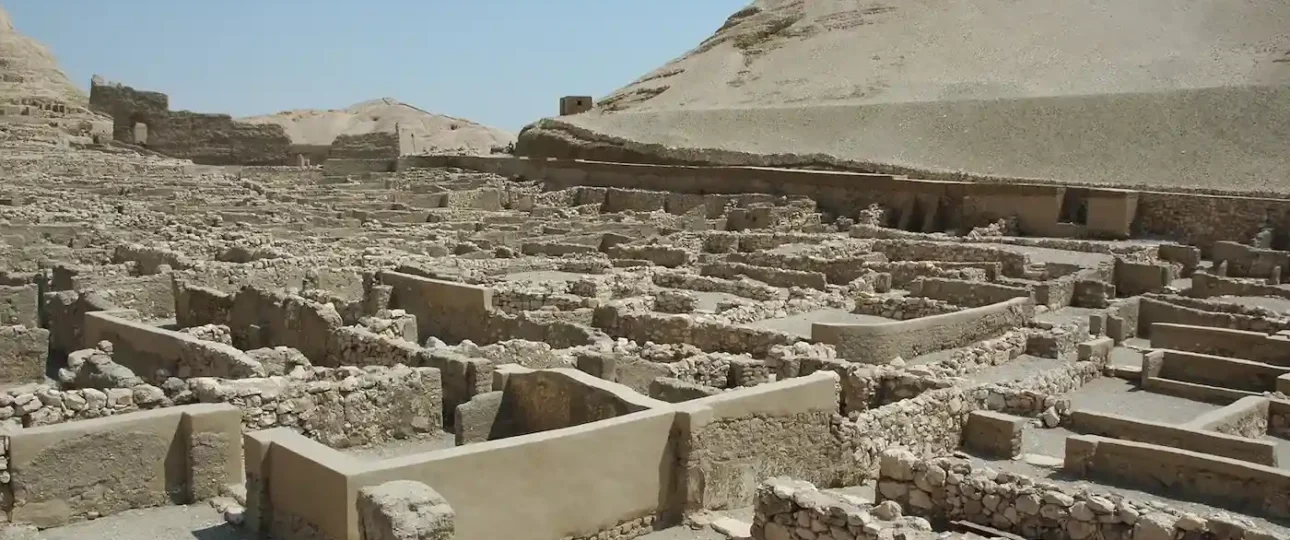Deir el-Medina: Unraveling the Lives of Ancient Egyptian Artisans
Introduction
Nestled on the West Bank of the Nile River, Deir el-Medina stands as an intriguing archaeological site that offers a unique glimpse into the daily lives and activities of ancient Egyptian artisans .Today, this hidden gem is often included in Nile Cruise itineraries, allowing travelers to explore its fascinating history as part of their journey along the river. Often referred to as the “Village of the Workers,” Deir el-Medina was home to the skilled craftsmen and laborers who built and decorated the tombs in the nearby Valley of the Kings and Valley of the Queens. In this article, we embark on a journey through time to explore the marvels of Deir el-Medina, delving into its historical context, residential structures, artistic achievements, and the enduring allure that reveals the intimate details of ancient Egyptian society.
Historical Context of Deir el-Medina
Deir el-Medina flourished during the New Kingdom, approximately from the Eighteenth to the Twentieth Dynasties, making it one of the longest-lived worker’s settlements in ancient Egypt. The village was established during the reign of Thutmose I and continued to be inhabited until the end of the Twentieth Dynasty.
1.1 The Workers of the Valley of the Kings
The skilled artisans and laborers of Deir el-Medina played a crucial role in the construction and decoration of the royal tombs in the Valley of the Kings. Their expertise and dedication ensured that the pharaohs’ final resting places were meticulously crafted and adorned.
1.2 A Unique Settlement Deir el-Medina was a tightly-knit
community of workers and their families, dwelling in a secluded village that was off-limits to the general public. Its isolation was meant to protect the tombs’ secrets and prevent unauthorized access to the sacred burial sites. Residential Structures of Deir el-Medina The village of Deir el-Medina was comprised of residential structures, communal buildings, and other amenities that catered to the needs of its inhabitants.
2.1 The Workers’ Homes
: A Glimpse into Everyday Life The homes of the artisans were modest but well-organized, featuring courtyards, living areas, and small storage rooms. The layout of these houses provides valuable insights into the daily lives of ancient Egyptian families.
2.2 Communal Buildings:
Places of Worship and Gathering Deir el-Medina had communal buildings, including a temple dedicated to the goddess Hathor, the patron deity of the village. The temple served as a place of worship, where the workers and their families could seek divine protection and blessings. Artistic Achievements of Deir el-Medina The artisans of Deir el-Medina were not only skilled laborers but also accomplished artists, showcasing their talents through various forms of artistic expression.
3.1 Tomb Decoration:
A Legacy of Beauty The artisans decorated not only the royal tombs but also their own burial sites with stunning murals and intricate reliefs. These artworks depicted scenes from daily life, religious rituals, and offerings to ensure a successful journey to the afterlife.
3.2 Personal Artifacts:
Intimate Expressions of Daily Life Archaeological excavations have unearthed numerous personal artifacts in Deir el-Medina, including jewelry, pottery, and tools. These items offer intimate insights into the craftsmen’s lives, their craftsmanship, and their personal preferences. The Social Structure of Deir el-Medina Deir el-Medina was a well-organized community with a distinct social structure that provided a sense of stability and unity among its residents.
4.1 Hierarchical Organization
The village had a hierarchical structure, with craftsmen holding various ranks based on their skills and experience. Some artisans achieved high status and enjoyed privileges, such as more comfortable accommodations and access to additional resources.
4.2 Scribes and Literacy
A remarkable aspect of Deir el-Medina was the relatively high literacy rate among its inhabitants. Scribes played crucial roles in documenting the village’s affairs, legal matters, and religious rituals. Modern-day Significance and Preservation Deir el-Medina remains an invaluable archaeological site that continues to offer significant contributions to our understanding of ancient Egyptian society and culture. For many visitors on a Nile Cruise, a stop here provides a rare opportunity to connect with the everyday lives of the artisans behind Egypt’s greatest monuments.
5.1 Ongoing Excavations and Research
Ongoing archaeological excavations and research at Deir el-Medina bring new discoveries to light, enriching our knowledge of the daily lives and achievements of ancient Egyptian artisans.
5.2 Cultural and Historical Heritage
Designated as a UNESCO World Heritage Site, Deir el-Medina is a precious cultural and historical treasure, protected to ensure its preservation for future generations.
Conclusion
Deir el-Medina, the “Village of the Workers,” reveals a captivating chapter in ancient Egyptian history, showcasing the lives and contributions of skilled artisans who crafted the tombs of pharaohs and queens. As we explore the homes, artistic achievements, and social structure of this extraordinary community, we gain a deeper appreciation for the artistry, skills, and intimate aspects of life in ancient Egypt.
NileTravel Machine invites you to embark on this mesmerizing journey to Deir el-Medina, where history and artistry intertwine, Whether you’re fascinated by hidden villages or grand temples, exploring Deir el-Medina as part of a Nile Cruise is an unforgettable way to discover the treasures of ancient Egypt.

